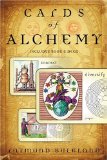
Cards of Alchemy
, by Raymond Buckland
Kit: Llewellyn Publications, 0738700533, 199 page book + 50 cards, 2003
Do not let the title fool you, or cause you to pass this deck by. You don’t need a working knowledge of alchemy for it to make sense (although that certainly wouldn’t hurt). Anyone, even someone with no knowledge of the subject of alchemy can find guidance within the contents of this deck and book combination. I would NOT recommend that you pick up the deck without the book, although you may simply want to get the book.
This is not a deck of cards for divining the future in the way of a standard Tarot. It is designed, by one of the more prominent figures (in my opinion) in the modern American Pagan/magickal community, to be a system of transformation for an individual.
The cards are unique in several ways. First, they are designed to be read horizontally, rather than vertically. Next, the symbolism on them is totally unlike any other deck. While still divided into “suits”, there are five suits of nine cards each, and five “Wild Cards”. Rather than elemental associations (which are reserved for the “Wild Cards”), the suits are assigned to various areas of human life (love, health, wealth, protection, and power). Each of the suits is divided into three sets of three, each set of which relates to a “degree” or level of experience. These levels are “Puffer” (Novice), “Initiate” (Experienced), and “Adept” (Master/Teacher)/. These grades are NOT related to magickal or Craft training, but are references to life experiences.
It is the intent of the creator of this deck to generate thought rather than to provide answers. In this it is more akin to the I-Ching than the Tarot. Because of the significant difference between the symbolism in this deck and that in a Tarot deck, of any design, I would recommend that you keep the book handy while working with this deck.
There are a number of layouts illustrated and explained: a four card spread called the “Star Cross”; a five card spread called “The Path”; and a seven card layout called the “Buckland Seven Star” spread. Each of these is thoroughly explained, as well as what the appearance of one (or more) “Wild Cards” in a reading means. The “Wild Cards” are similar to the Major Arcana cards in their influence.
There are a couple of paragraphs devoted to the use of this deck in standard Tarot layouts and as a divination tool for yourself or others; but this in the form, it appears to me, of an afterthought. The primary purpose of this deck is for inner development and knowledge and I would recommend that, at least in the beginning, that is what you restrict it to.
The major illustrations on each card are drawn from a wide variety of alchemical texts spanning nearly a millennium (from the tenth through the nineteenth Centuries), even though the additions by the author (the suits, grades, keyword, astrological balance, and stone of destiny) are modern. Each card is nicely illustrated, clearly drawn, and well laid out. The colors are pleasant and evocative.
The author has redrawn images from ancient texts. If he has modified them (an he does so), he tells you how they differ from the original illustrations. The major change he has introduced in many of them is in the use of colors and, occasionally, the deletion of some of the wording which appeared in the originals.
The designs on the “Wild Cards” is slightly different, as is to be expected. Each of them contains two separate illustrations, an elemental association, a keyword, and a ruling planet.
Also included are cards illustrating, and explaining. Each of the layouts (illustrations are on one side of the card, with the explanation on the reverse). There is also a card illustrating the “degrees” on one side (with a brief description of what each means) and the suits on the reverse side (identifying each and showing the area of life it is associated with.
If you are willing to experiment with the information contained in this set, and are willing to be honest with yourself, this set should help you towards a deeper understanding of yourself and your relationship to the external world.








